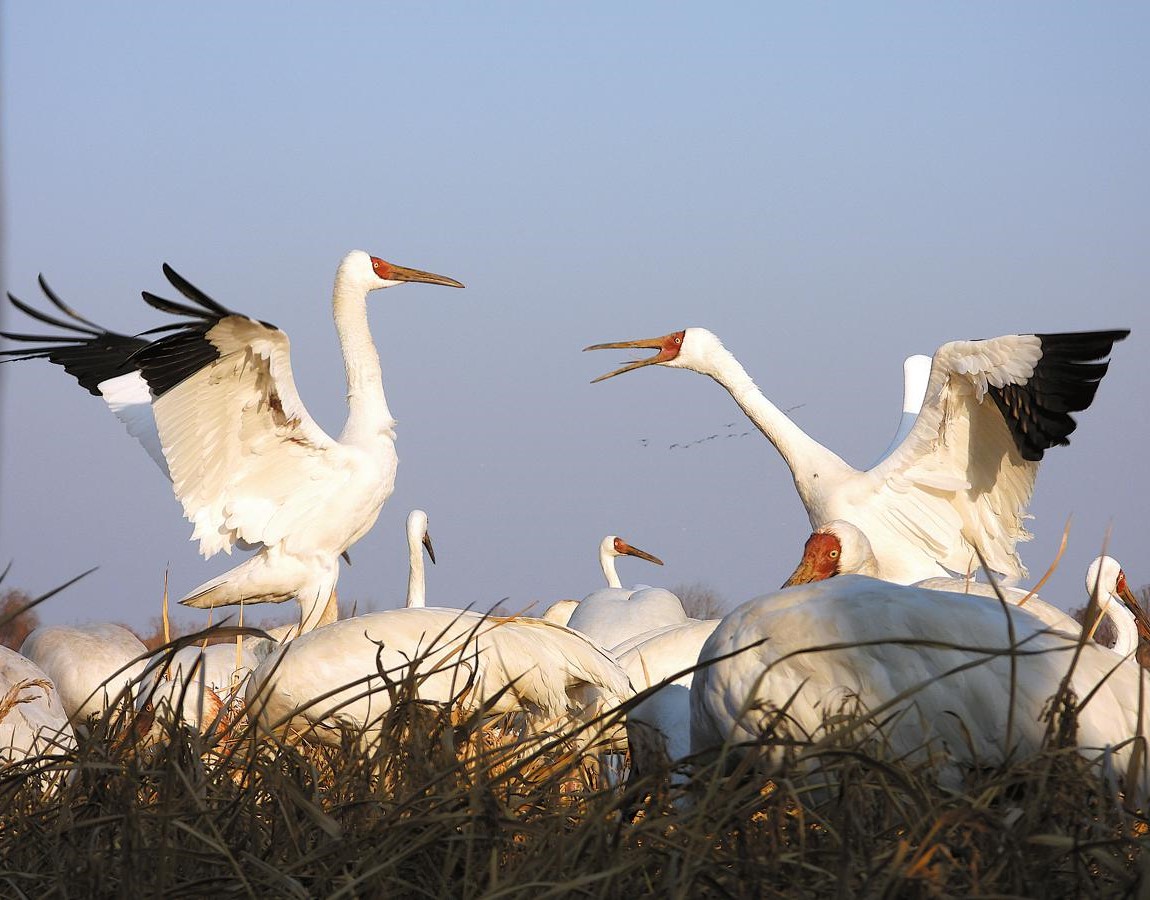Siberian cranes adapt to climate change
As droughts, floods hit Poyang Lake, endangered birds take to farms as food source


Farmyard flock
As midday approached on Oct 16, 2020, Yao Tianle and several colleagues were patrolling farmland near the Poyang Lake Basin when he suddenly noticed a large number of Siberian cranes feeding on rice in a nearby paddy field.
Yao had just been appointed Party secretary of Chaqizhou Reclamation Farm, a branch of the Kangshan Reclamation Farm in Yugan county, Jiangxi.
It was the first time he'd seen so many Siberian cranes foraging in farmland. He immediately called the local wildlife protection station.
Lei Xiaoyong, then director of the wildlife protection station, quickly arrived on the scene. They reported the situation to the higher authorities.
The local government and forestry department took the matter seriously and decided to compensate farmers for their losses.
"At first, the farmers were unwilling to accept the situation. When they saw the migratory birds, they would try to drive them away. Then, village officials would intervene and provide compensation according to regulations," Yao said.
From 2020 onward, during the wintering season for migratory birds, which typically lasts from mid-October to March, the number of birds at Chaqizhou has continually increased.
Siberian cranes are revered as "living fossils", with a globally rare population. In China, they are classified as first-class protected wildlife.
Poyang Lake serves as a primary wintering habitat for cranes and various other migratory birds. Each year, hundreds of thousands of migratory birds flock to the lake for the winter.
According to a survey conducted by Beijing Forestry University from December 2021 to February 2022, the global wintering population of cranes in China was about 5,600.
Among them, approximately 4,800 wintering cranes were recorded at Poyang Lake, accounting for 85.7 percent of the total.
Lei said he believes the increase of cranes and other migratory birds from the protected wetland of Poyang Lake into farmlands has been influenced by extreme weather conditions in the past years.
"The birds mainly fed on the winter buds of submerged plants such as tape grass found in shallow waters and mud flats," he said.
"However, extreme weather affects the hydrology of Poyang Lake. For instance, droughts can reduce the population of submerged grasses, threatening the birds' food source. In contrast, during floods, water can submerge their food, prompting them to venture into farmlands in search of food," Lei said.
In 2020, a cold wave influenced migration patterns, causing migratory birds to arrive earlier.
Coupled with high water levels in Poyang Lake and prolonged periods of flooding, the growth of winter buds of tape grass was severely impacted.
As a result, birds began frequenting the surrounding rice fields.
In recent years, during the winter months, large numbers of migratory birds have increasingly been spotted in lakeside areas and even deeper into farmlands.
Besides the Kangshan farm, other areas around the lake, such as the Liyuzhou Wuxing Reclamation Farm and Henghu Reclamation Farm in Nanchang, and even locations farther from the lake such as Ruichang and Fengcheng cities, have also seen numerous migratory birds foraging in lotus ponds and rice fields.
In 2022, Poyang Lake experienced severe drought, leading to vast wetlands drying up, soil cracking, vegetation dying, and a decrease in bird habitats and food sources.
That year, at the Liyuzhou Wuxing Reclamation Farm, farmers saw hundreds of migratory birds entering farmlands, leaving less than about 200 out of some 670 hectares of rapeseed fields untouched.
Climate woes
Dai Nianhua, vice-president of the Ecological Society of Jiangxi Province, has been conducting hydrological and biodiversity research at Poyang Lake for many years.
According to his observations, starting over a decade ago, the growth of submerged plants in Poyang Lake has been inhibited by the dual impact of summer floods and autumn droughts, leading migratory birds to increasingly forage in artificial wetlands such as lotus ponds and farmlands around Poyang Lake.
"The deteriorating natural habitats for migratory birds create difficulties in finding food. Birds cannot survive without food, so they are forced to seek sustenance in artificial wetlands and rice fields," he said.
"In the 1980s and 1990s, Poyang Lake was designated a national wetland protection area, along with several other protected zones. However, since the 21st century, there have been significant changes in the hydrology of Poyang Lake. Drought conditions have gradually become particularly severe," he added.
Poyang Lake's water levels have reached record lows in recent years.
In September 2022, the water level dropped to 7.1 meters, the lowest recorded since 1951.
By 2023, the overall water level remained low, with the Xingzi Station — a key hydrological station for Poyang Lake — reporting a water level of around 12 meters on July 20, marking the earliest onset of the dry season ever recorded.
Dai pointed out that in addition to global climate change, abnormal precipitation in the region and human activities — such as the operation of large control reservoirs upstream of the Yangtze River and sand mining in Poyang Lake — have also worsened the drought conditions.
Since 2020, there has been an increase in the number of migratory birds. To address the food shortage of those birds, starting in 2021, the Kangshan farm has set aside 67 hectares of rice fields for birds in winter.
The local government has hired dozens of caretakers to monitor 17 bird and wetland sites across the area.
Several regions around Poyang Lake have also begun to provide food for migratory birds. For example, the lotus pond set aside for migratory birds in Liyuzhou has expanded from over 20 hectares in 2016 to over 70 hectares in 2022.
Lei emphasized that providing food for migratory birds is a "critical measure to address their immediate needs when they lack food, serving as a protective project".
"Around eight or nine years ago, some cranes migrated to Wuyuan county and died. Upon examination, it was discovered that their intestines were empty and they had almost no body fat. This indicated a severe food shortage at that time," he said.
Since 2014, Jiangxi has been implementing wetland ecological protection compensation for those who suffer economic losses created by migratory birds.
According to data from the Jiangxi Provincial Forestry Department, over the past decade, Jiangxi has invested over 375 million yuan ($51.4 million) in wetland ecological protection compensation, covering over 10,900 hectares of damaged crops.
























